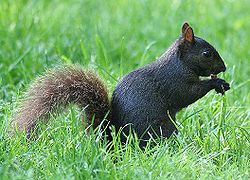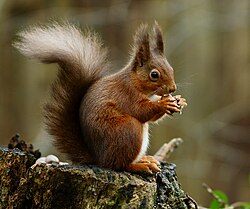Squirrel
Squirrels are a large family of small to medium rodents. It includes tree squirrels, which are described on this page.
| Squirrel | |
|---|---|

| |
| Eastern Gray Squirrel, Sciurus carolinensis | |
| Scientific classification | |
| Kingdom: | |
| Phylum: | |
| Class: | |
| Order: | |
| Family: | |

The other squirrels are: ground squirrels, chipmunks, marmots (including groundhogs), flying squirrels, and prairie dogs.
Squirrels are native to the Americas, Eurasia, and Africa, and have been introduced to Australia. The earliest known squirrels date from the Eocene and are most closely related to the mountain beaver and to the dormouse among living rodent families.
Most squirrels are omnivores; they eat anything they find. Many kinds of squirrels live in trees, so they often find nuts. They eat seeds, berries, and pine cones too. Sometimes they eat bird's eggs and insects. Most tree squirrels store food in the fall, to eat in the winter. Ground squirrels do not store food. They hibernate which means they spend winter in a deep sleep.
Squirrels have many predators, or enemies. Their predators are foxes, wolves, coyotes, bears, raccoons, lynxes, cougars, weasels, cats, dogs, badgers, snakes, and birds of prey.
Tree squirrels
The most common European squirrels are red or brown in color, while common American squirrels are grey or black. Grey squirrels have been introduced from America into Europe (most notably, Great Britain).
The greys carry a virus to which they are immune, but which is deadly to red squirrels.[1] They have taken over most of the red squirrels' territory in deciduous forest. This has greatly reduced the red squirrel's population. Red squirrels still enjoy dominance in the pine forests of northern Britain, but they are now rare in southern areas.
The grey squirrel is regarded as vermin. It is illegal to release any into the wild, and any caught have to be humanely killed.[2][3]
Life cycle
Squirrels breed in February and March in winter, and in June and July in summer. Females may become pregnant up to twice a year. Usually four to six young are born, after a gestation period (pregnancy) of around thirty-nine days. Only the mother looks after the young, which are born completely helpless. Young squirrels are deaf and blind during the first few weeks of their life.
Most squirrels die in the first year of life. Adult squirrels can have a lifespan of five to ten years in the wild. Some can survive 10 to 20 years in captivity.[4]
As pets
Squirrels are considered exotic pets and are legal in only some parts of the world. Areas where they can be kept as pets include Canada and parts of Australia (in New South Wales only) and the United States (in 21 states). They are considered wild animals in most European countries and pests or potential pests in many countries, such as New Zealand and most of Australia.
Summary table
| Country | Legal status and information |
|---|---|
| In New South Wales, northern palm squirrels can be kept as pets if the owner holds a license issued by the Department of Primary Industries (DPI) or if the squirrel has to be numerically identified with a microchip or an ear tattoo and the owner must have a certificate from a vet that can verify that the animal has been desexed.[5] In 2010, there were eight licensed squirrel breeders in New South Wales and five pet stores in Sydney that sold them.[6] In Queensland,[7] Victoria[8] and Western Australia,[9] squirrels are considered pests and cannot be kept as pets. | |
| Squirrels may be kept as pets in all provinces and territories of Canada.[10] | |
| The red squirrel is a protected species in France and cannot be kept as a pet.[11] | |
| It is illegal to keep a pet squirrel in Germany, as they are considered wild animals.[12] | |
| It is illegal to import any species of squirrel into New Zealand.[13] | |
| It is illegal to keep a squirrel as a pet in the United Kingdom.[14] | |
| It is illegal to keep a squirrel as a pet in 28 states and in the District of Columbia, although they may be kept as pets in 21 states. Of these 21 states, no license is needed to keep a squirrel as a pet in 14 states while a license is needed in seven states. It is unknown whether or not squirrels may be kept in Florida, Nevada or North Dakota.[15] |
Squirrel Media
Skull of an Oriental giant squirrel (genus Ratufa)—note the classic sciuromorphous shape of the anterior zygomatic region.
Young squirrels, known as kits
Squirrel eating a fruit in Manyara National Park, Tanzania
Red squirrel in the Seurasaari island in Helsinki, Finland. The tame red squirrels on that island have become accustomed to humans thanks to their long-term feeding.
Squirrel retrieving and eating pumpkin seeds.
A fox squirrel (Sciurus niger) outside the Cleveland Museum of Art
A squirrel (Callosciurus erythraeus thaiwanensis) in Japan
Three-coloured Prevost's Squirrel (Callosciurus prevostii) in Zagreb Zoo, Croatia
Related pages
References
- ↑ BBC 3003. Virus threatens UK's red squirrels. BBC News. [1]
- ↑ Malvern, Jack. Captured squirrels live to nibble again | The Times. http://www.thetimes.co.uk/tto/law/article2210685.ece. Retrieved 2013-04-08.
- ↑ "Control of invasive non-native species - Grey Squirrels". Retrieved 2013-04-08.
- ↑ Thorington, Richard W.; Koprowski, John L.; Steele, Michael A.; Whatton, James F. (2012). Squirrels of the World. Johns Hopkins University Press. p. 12. ISBN 978-1421404691.
- ↑ https://www.dpi.nsw.gov.au/content/archive/news-releases/agriculture/2007/illegal-squirrels
- ↑ https://www.smh.com.au/national/nsw/squirrels-on-sale-trendy-pets-or-just-a-little-nuts-20100731-110mj.html
- ↑ "Archived copy" (PDF). Archived from the original (PDF) on 2023-08-11. Retrieved 2023-07-13.
{{cite web}}: CS1 maint: archived copy as title (link) - ↑ "Archived copy". Archived from the original on 2023-07-13. Retrieved 2023-07-13.
{{cite web}}: CS1 maint: archived copy as title (link) - ↑ https://www.agric.wa.gov.au/palm-squirrel
- ↑ "Archived copy". Archived from the original on 2023-07-13. Retrieved 2023-07-13.
{{cite web}}: CS1 maint: archived copy as title (link) - ↑ https://ecureuils.mnhn.fr/ce-que-dit-la-loi
- ↑ "Archived copy". Archived from the original on 2023-07-13. Retrieved 2023-07-13.
{{cite web}}: CS1 maint: archived copy as title (link) - ↑ https://www.epa.govt.nz/industry-areas/new-organisms/prohibited-organisms-in-new-zealand/
- ↑ "Archived copy". Archived from the original on 2023-07-13. Retrieved 2023-07-13.
{{cite web}}: CS1 maint: archived copy as title (link) - ↑ https://worldpopulationreview.com/state-rankings/pet-squirrel-legal-states








